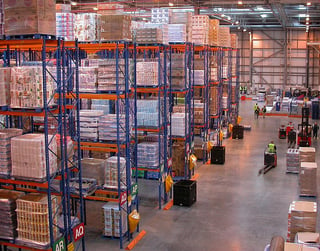What Are the Supply Chain Hurdles SCPs Will Face in 2016?
Nick Ostdick - February 02, 2016

If you ask any supply chain planner (SCP), they’ll tell you the beginning of a new year is both exciting and stressful. As with each new year, new products are being prepped for rollout, OEM production is looking to ramp back up as spring and summer approach, and SCPs are faced with a number of potential pitfalls given unpredictable winter weather and holiday-related snafus or delays in product delivery and inventory.
 But given the rapid pace at which supply chain logistics have evolved during the last 5 to 10 years, it’s now common for each new year to bring a new set of challenges SCPs must address in order to stay efficient and cost-effective.
But given the rapid pace at which supply chain logistics have evolved during the last 5 to 10 years, it’s now common for each new year to bring a new set of challenges SCPs must address in order to stay efficient and cost-effective.
From transportation management to collaboration across a company’s entire sales and operations (S&OP) division, here are just a few of the supply chain hurdles SCPs will likely face in 2016.
Transportation
 While this may be an issue SCPs will perpetually have to address, transportation is perhaps one of the most complex issues of 2016. With a greater focus on global hubs, predictive transportation modeling, and Green Energy solutions, SCPs will have to become increasingly creative in how to most effectively ensure on-time delivery, accuracy of inventory, and reduction of overall freight costs. Leveraging trailer loading versus air transit, third-party freight partnerships, and implementation of an integrated transportation management system (TMS) are just a handful of the decisions SCPs will have to face as they strive to maintain productivity and streamline supply chain processes.
While this may be an issue SCPs will perpetually have to address, transportation is perhaps one of the most complex issues of 2016. With a greater focus on global hubs, predictive transportation modeling, and Green Energy solutions, SCPs will have to become increasingly creative in how to most effectively ensure on-time delivery, accuracy of inventory, and reduction of overall freight costs. Leveraging trailer loading versus air transit, third-party freight partnerships, and implementation of an integrated transportation management system (TMS) are just a handful of the decisions SCPs will have to face as they strive to maintain productivity and streamline supply chain processes.
Market Expansion
 It’s no secret the name of the game in 2016 will be the continued expansion and globalization in supply chain logistics and operations planning. Given the recent developments with the Trans Pacific Partnership (TTP), companies could now more than ever have the ability to establish themselves in new markets and create new supply and distribution hubs to engage new customer pools. However, this potential for rapid growth does not come without its share of potential complications. The complexities of a market’s taxation, shifting political policies, competition for resources, and economies of scale are important concerns for any supply chain manager when looking to begin operations in a new region.
It’s no secret the name of the game in 2016 will be the continued expansion and globalization in supply chain logistics and operations planning. Given the recent developments with the Trans Pacific Partnership (TTP), companies could now more than ever have the ability to establish themselves in new markets and create new supply and distribution hubs to engage new customer pools. However, this potential for rapid growth does not come without its share of potential complications. The complexities of a market’s taxation, shifting political policies, competition for resources, and economies of scale are important concerns for any supply chain manager when looking to begin operations in a new region.
From a supply perspective, this is where the utilization of Big Data and in-depth, real-time reporting will be crucial in establishing best practices and leveraging value-added solutions to ensure operations in these new markets function as cost-effectively as possible. For example, an integrated transportation management system (TMS) would be vital in tracking the quantity of product shipped, the reliability of delivery, freight methods and routes – rail, air, etc – and overall ROI with any potential third-party freight partners. These functions would be crucial in considering the costs of doing business in a new market and providing supply chain managers with the best data possible to make educated, financially-sound decisions.
Technological Integration
Of course, technology and the integration of advanced systems across the supply chain landscape is a core driver in supply chain efficiency, but such concerns are also crucial in fostering communication between SCPs and the rest of the organization. But this year's trends such as Big Data and the Internet of Things will make it that much more important for SCPs to adopt integrated systems. Integrated systems will be used to produce real-time reporting and analysis, advanced simulations, and support forecasting and resource planning. This will be essential to not only keep pace with competitors, but also maintain relevancy as the supply chain world moves more and more towards a complete digitization.
Collaboration and Connectivity
The ability to share information, generate comprehensive, real-time reporting, and collaborate internally and with third-party vendors will be another top priority for SCPs going into 2016. As the supply chain industry diversifies and becomes more and more spread out, collaboration between departments and greater connectivity through shareable data and advanced supply chain management systems will be key in driving productivity and reducing costs. Buzz words aside, an SCPs ability to generate on-the-spot reporting and share that data with with key cross-functional team members will lead to greater transparency and understanding in terms of product inventory and holdings, as well as a greater agility in troubleshooting supply disruptions and bottlenecks.
What’s a SCP to do to clear these hurdles?
Simply put, through integrated technology and the demand for real-time data and reporting, SCPs must address each of these hurdles as a whole and not as separate problems without any interconnectivity. These potential pitfalls share a number of the same components, and therefore, the supply chain solutions of the future must provide full visibility of such dependencies in order to provide SCPs with the necessary information to make key decisions that result in the least over all disruption.
LATEST POSTS
- Understand Circular Economy in The Manufacturing Industry
- How Can Industry 4.0 IT Integration Be Achieved Smoothly?
- The Significance of Order Sequencing in Discrete Manufacturing
- How to improve your Supply Chain Management: The Power of Control Towers
- Optimizing Human Resource Scheduling in Manufacturing: A Technological Approach



